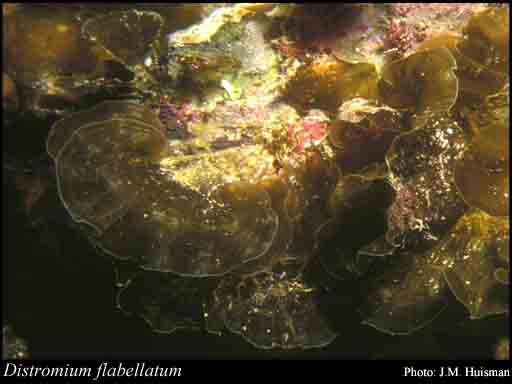- Reference
- Austral.J.Bot. 15:218-220, Fig. 3 (1967)
- Conservation Code
- Not threatened
- Naturalised Status
- Native to Western Australia
- Name Status
- Current

Scientific Description
Habit and structure. Thallus medium to dark brown, more or less erect, usually 3–6(–8) cm long and across, flabellate when young and becoming split into few to numerous flabellate segments, attached by a matted rhizoidal holdfast 0.2–1.2 cm across and 0.2–0.8 cm long, with descending multicellular rhizoids from the lower side of the mid to lower thallus; epilithic or epiphytic on Amphibolis. Growth from a row of many apical cells, becoming distromatic in subapical cells. Fronds complanate, 1–3(–6) mm broad below, 5–20(–35) mm broad at their apices. Structure two cells and 70–90 µmthick throughout; cells in surface view 20–35(–40) µmacross, L/B2–5(–7). Hairs in prominent concentric bands on lower surface of thallus, 30–40(–50) µmin diameter, simple or with a lateral branch 2–5 cells from their base, arising from cells cut off from one end of the lower thallus cells, without a basal meristem but with apical growth.
Reproduction. Sporangia in concentric, often interrupted, sori or patches on the upper surface, external to the thallus, with the parent thallus cell subdividing usually after the sporangium is cut off, with a membranous indusium, sporangia ovoid to subspherical or pyriform, 150–250 µm in diameter, dividing tetrahedrally.
Distribution. From Coral Bay, W. Aust., around southern Australia to Port Phillip, Vic. and Deal I., Bass Strait.
Habitat. D. flabellatum occurs from 1 to 36 m deep.
[After Womersley, Mar. Benthic Fl. Southern Australia II: 230–232 (1987)]
Distribution
- IBRA Regions
- Geraldton Sandplains.
- IBRA Subregions
- Geraldton Hills.
- IMCRA Regions
- Abrolhos Islands, Central West Coast, Leeuwin-Naturaliste, Ningaloo, WA South Coast.
- Local Government Areas (LGAs)
- Albany, Augusta Margaret River, Carnarvon, Cockburn, Coorow, Esperance, Greater Geraldton, Irwin.